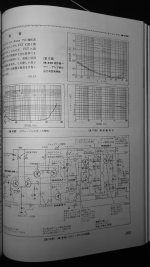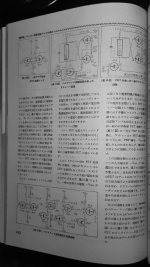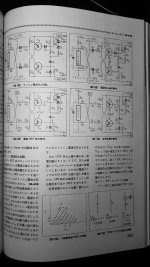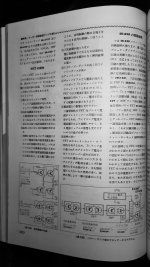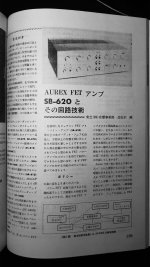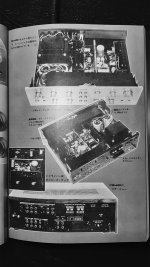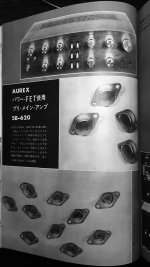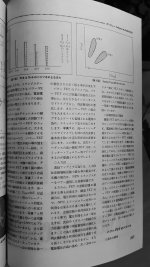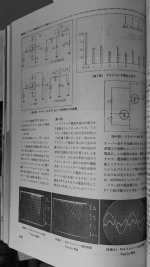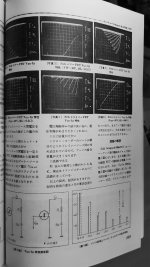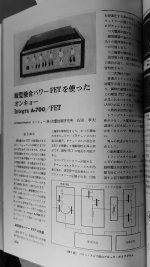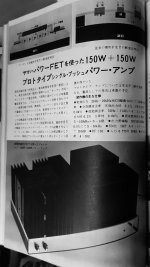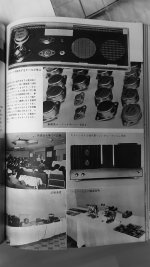Here I would like to address the little known events of the early (1973-75) V-FET history.
While it is not very logical to discuss these issues on DIY forum, considering the international
membership and technical expertise, and in the interests of the history preservation I decided
to do it on this forum.
Besides, history + archeology = treasures.
Those years were, in fact, the peak of the industry interest and involvement with the V-FET.
And that all started, as we know, in Japan. The first name we should start with is Toshiba.
Creating in 1973 their high-end audio division Aurex they immediately set standards
very high with the very advanced tuner ST-910. On the audio front they were busy developing
their V-FET (complementary outputs and drivers), which they had in the beginning of 1974.
By 1975 they have the production prototype amp SB-620, (here is their prototyping circuit):

and then...something strange have happened: the SB-620 was completely redesigned into
all BJT design! As we will see this was progressing like a plague...
Talking about Toshiba components in those years, I would ask: shouldn't there be a control
amplifier SY-910 (to supplement their tuner and power amp SC-910, mentioned on the TVK)?
↴
While it is not very logical to discuss these issues on DIY forum, considering the international
membership and technical expertise, and in the interests of the history preservation I decided
to do it on this forum.
Besides, history + archeology = treasures.
Those years were, in fact, the peak of the industry interest and involvement with the V-FET.
And that all started, as we know, in Japan. The first name we should start with is Toshiba.
Creating in 1973 their high-end audio division Aurex they immediately set standards
very high with the very advanced tuner ST-910. On the audio front they were busy developing
their V-FET (complementary outputs and drivers), which they had in the beginning of 1974.
By 1975 they have the production prototype amp SB-620, (here is their prototyping circuit):
and then...something strange have happened: the SB-620 was completely redesigned into
all BJT design! As we will see this was progressing like a plague...
Talking about Toshiba components in those years, I would ask: shouldn't there be a control
amplifier SY-910 (to supplement their tuner and power amp SC-910, mentioned on the TVK)?
↴
Last edited:
Now, here is a reference from the summer of 1974:

So, in addition to Toshiba, Pioneer also was involved in that game... To this day, I was not able
to find any trace of their work. HFE lists two Pioneer Japanese catalogs from 1974 and 1976,
with nothing V-FET related. So, it will be interesting to find the other Pioneer Japanese catalogs,
preferably, Fall-'74 and Spring-'75. ↴
So, in addition to Toshiba, Pioneer also was involved in that game... To this day, I was not able
to find any trace of their work. HFE lists two Pioneer Japanese catalogs from 1974 and 1976,
with nothing V-FET related. So, it will be interesting to find the other Pioneer Japanese catalogs,
preferably, Fall-'74 and Spring-'75. ↴
Next. In those 2 years the industry was very enthusiastic about V-FET development
and have organized several roundtables to discuss the V-FET future.
Here is the list of the participants in one such event (1974):
Kentaro Tani (Pioneer), Kazumasa Sakai (Trio), Shinichiro Ishii (Technics),
Hisashi Suwa (Sony), Kiyohiko Ito (Yamaha).
Sony, Yamaha - of course, Pioneer - OK, but now we have two new players:
Trio (Kenwood) and Technics.
Well, Trio did leave some traces of their V-FET work (1974-75).
Here is their prototyping work on the complementary V-FET output stage with
protection arrangement:

But how far did they progress with the completed design towards production?
Which V-FETs they were working with? ↴
and have organized several roundtables to discuss the V-FET future.
Here is the list of the participants in one such event (1974):
Kentaro Tani (Pioneer), Kazumasa Sakai (Trio), Shinichiro Ishii (Technics),
Hisashi Suwa (Sony), Kiyohiko Ito (Yamaha).
Sony, Yamaha - of course, Pioneer - OK, but now we have two new players:
Trio (Kenwood) and Technics.
Well, Trio did leave some traces of their V-FET work (1974-75).
Here is their prototyping work on the complementary V-FET output stage with
protection arrangement:
But how far did they progress with the completed design towards production?
Which V-FETs they were working with? ↴
For Technics - I didn't find any trace of their circuit development, but Matsushita
Semiconductors Division was also active in the development of V-FET and here are
the results of their work:
JPS51-123074 -PRODUCTION PROCESS OF FET • Matsushita Electric • 1976-10-27
Earliest priority: 1975-04-18
PURPOSE: In the production of multi-channel vertical type JFET simplifying the forming
process of the substrate of N<->-N<+> type structure to reduce process steps.
JPS51-135376 -JUNCTION TYPE FIELD EFFECT TRANSISTOR • Matsushita Electric • 1976-11-24
Earliest priority: 1975-05-19
PURPOSE: To obtain longitudinal type JFET which has a large voltage amplification factor,
uniform rise current characteristic and triode tube type output characteristic. ↴
Semiconductors Division was also active in the development of V-FET and here are
the results of their work:
JPS51-123074 -PRODUCTION PROCESS OF FET • Matsushita Electric • 1976-10-27
Earliest priority: 1975-04-18
PURPOSE: In the production of multi-channel vertical type JFET simplifying the forming
process of the substrate of N<->-N<+> type structure to reduce process steps.
JPS51-135376 -JUNCTION TYPE FIELD EFFECT TRANSISTOR • Matsushita Electric • 1976-11-24
Earliest priority: 1975-05-19
PURPOSE: To obtain longitudinal type JFET which has a large voltage amplification factor,
uniform rise current characteristic and triode tube type output characteristic. ↴
Now, my understanding that JVC JS-M7 schematic is not available, so may be their prototyping
arrangements for the amp and sophisticated protection will be of some guidance:

Employing two pairs of the V-FET outputs they have also included compl. drivers (bjt-?) before them.

↴
arrangements for the amp and sophisticated protection will be of some guidance:
Employing two pairs of the V-FET outputs they have also included compl. drivers (bjt-?) before them.
↴
Last edited:
Now, for a few ghosts on the market.
Onkyo did advertise their V-FET amp Integra A-700 by 1975, but the actual destiny
of this model is not known... ↴
Onkyo did advertise their V-FET amp Integra A-700 by 1975, but the actual destiny
of this model is not known... ↴
Even more interesting is the case of Optonica.
In their Fall-'74 catalog they advertised their V-FET amp SM-6000. In fact, ~2 years
ago one was for sale on Japanese auction, and the catalog.

Typical three diff. stages, with compl V-FET drivers and outputs, all-fet design,
also FET input and compl V-FET buffers in RIAA section.
Again, for some reason by spring-'75 (catalog) it was redesigned (circuitry, boards,
front panel), with improvements, into SM-6000V, and not just one model, but now
with -5000V -2000V:

And their destiny is also not known... ↴
In their Fall-'74 catalog they advertised their V-FET amp SM-6000. In fact, ~2 years
ago one was for sale on Japanese auction, and the catalog.
Typical three diff. stages, with compl V-FET drivers and outputs, all-fet design,
also FET input and compl V-FET buffers in RIAA section.
Again, for some reason by spring-'75 (catalog) it was redesigned (circuitry, boards,
front panel), with improvements, into SM-6000V, and not just one model, but now
with -5000V -2000V:
And their destiny is also not known... ↴
Still, Optonica did have one amp as hiccup that is still available in Asia - SM-2500.
It is using 2SK79 in a simple 2 FET stages RIAA section (like Sony):

↴
It is using 2SK79 in a simple 2 FET stages RIAA section (like Sony):
↴
Here is the post which shows how difficult it is to discover the ancient history,
when even serious Japanese collectors may not know what was manufactured ~50y. ago:
https://audiokarma.org/forums/index.php?threads/maybe-a-new-v-fet.70693/ -post#1
I will also add an interesting opinion from someone in Japan:
"Around 1974-75, audio V-FETs were developed by Yamaha, Sony, NEC, Hitachi, etc.
It was on the verge of breakout, but a certain demagogue named Narita suddenly
appeared. At that time, he contributed an apparently preposterous article to
several audio technology magazines, claiming that V-FETs were useless.
And disappeared, disrupting the audio world.
Thinking about it now, I wonder why such a nonsense article was published in
each magazine. I can only assume that there was "political" pressure.
After this incident, it overlapped with the decline of audio, and V-FET could
not play a leading role. It disappeared...
Considering that there is nothing that surpasses this as a low-loss component
for DC/AC or DC/DC power converters, it is quite conceivable that some forces
would be in trouble if V-FET became the global standard...
Was Narita a so-called "operative"? Even in the interview article at the time,
he was playing with a clearly non-theoretical discourse. Even now, when I read
it again, I am amazed. Because the way he talk is like a scammer."
Even at this forum one can find posts with the same (negative) view on V-FET...
when even serious Japanese collectors may not know what was manufactured ~50y. ago:
https://audiokarma.org/forums/index.php?threads/maybe-a-new-v-fet.70693/ -post#1
I will also add an interesting opinion from someone in Japan:
"Around 1974-75, audio V-FETs were developed by Yamaha, Sony, NEC, Hitachi, etc.
It was on the verge of breakout, but a certain demagogue named Narita suddenly
appeared. At that time, he contributed an apparently preposterous article to
several audio technology magazines, claiming that V-FETs were useless.
And disappeared, disrupting the audio world.
Thinking about it now, I wonder why such a nonsense article was published in
each magazine. I can only assume that there was "political" pressure.
After this incident, it overlapped with the decline of audio, and V-FET could
not play a leading role. It disappeared...
Considering that there is nothing that surpasses this as a low-loss component
for DC/AC or DC/DC power converters, it is quite conceivable that some forces
would be in trouble if V-FET became the global standard...
Was Narita a so-called "operative"? Even in the interview article at the time,
he was playing with a clearly non-theoretical discourse. Even now, when I read
it again, I am amazed. Because the way he talk is like a scammer."
Even at this forum one can find posts with the same (negative) view on V-FET...
Some more info about the SB-620 prototype - the power FET were S1348 (driver) and S1347 / S1378 (output). The single online reference to these I found speculates Toshiba decided not to pursue this technology and sold it off to NEC who then marketed the "stones" as the much better known 2SK70 / 2SJ20.
Attachments
Integra A-700, using P-channel driver and complementary outputs, but no part numbers are mentioned as far as I can tell...
Attachments
Fascinating! I have been a big fan of the Yamaha V-FET amps. Do you have any insight into Yamaha's development of these amps?
Is a copy of this article available?...
I will also add an interesting opinion from someone in Japan:
"Around 1974-75, audio V-FETs were developed by Yamaha, Sony, NEC, Hitachi, etc.
It was on the verge of breakout, but a certain demagogue named Narita suddenly
appeared. At that time, he contributed an apparently preposterous article to
several audio technology magazines, claiming that V-FETs were useless.
And disappeared, disrupting the audio world.
Thinking about it now, I wonder why such a nonsense article was published in
each magazine. I can only assume that there was "political" pressure.
...
V-FET comments from S. Narita:
MJ-1975 #3
● V-FET Why do power amps sound bad? ・・・・・ Shunichi Narita● ・・・ (p. 98)
MJ-1975 #6
■ Roundtable: Thinking about V-FET Amplifiers Again [Part 1] ・・・・・ (p. 129)
Attendants: Shunichi Narita●, Akira Yasui, Moe Ochiai, Akihiko Kaneda,
Juro Hoshi, Hisashi Suwa, Katsuaki Tsurushima, Ogawa
MJ-1975 #7
■ Roundtable: Thinking about V-FET amplifiers again [Part 2] ・・・・・ (p. 125)
Attendants: Shunichi Narita●, Akira Yasui, Moe Ochiai, Akihiko Kaneda,
Juro Hoshi, Hisashi Suwa, Katsuaki Tsurushima, Chuyu Morikawa
As for this forum, you can enjoy this post:
https://www.diyaudio.com/community/threads/has-somebody-used-igbt-in-power-amp.908/page-2#post-6355
MJ-1975 #3
● V-FET Why do power amps sound bad? ・・・・・ Shunichi Narita● ・・・ (p. 98)
MJ-1975 #6
■ Roundtable: Thinking about V-FET Amplifiers Again [Part 1] ・・・・・ (p. 129)
Attendants: Shunichi Narita●, Akira Yasui, Moe Ochiai, Akihiko Kaneda,
Juro Hoshi, Hisashi Suwa, Katsuaki Tsurushima, Ogawa
MJ-1975 #7
■ Roundtable: Thinking about V-FET amplifiers again [Part 2] ・・・・・ (p. 125)
Attendants: Shunichi Narita●, Akira Yasui, Moe Ochiai, Akihiko Kaneda,
Juro Hoshi, Hisashi Suwa, Katsuaki Tsurushima, Chuyu Morikawa
As for this forum, you can enjoy this post:
https://www.diyaudio.com/community/threads/has-somebody-used-igbt-in-power-amp.908/page-2#post-6355
Last edited:
Thanks StevenOH for sharing these quotes.
Do you mind sharing the source as requested in #16?
Much appreciated!
Do you mind sharing the source as requested in #16?
Much appreciated!
Citizen, all the references in my posts are old, and that information is in Japanese
magazines MJ 無線と実験 from 1974-75.
Talking about Yamaha development process, it was presented in this magazine:
Yamaha B-1 development - MJ-1974-#6, 1975-#2.
It is not much what I can say in this regard:
Their V-FET 2SJ25 and J27 were not a good complements to the N-ch parts, so designers had
to abandon the symmetrical complementary circuits in favor of LTP and SEPP symmetry design.
Their 2SK77 outputs initially were developed as 300W transistors, but then were scaled down
to 200W level.
I can also speculate, that Yamaha might have tried to improve their P-ch V-FETs to better
complement their N-ch parts with the new parts as 2SJ34...J37, but who knows...pure speculation...
there is no info about these parts anywhere (just my first logical guess).
The other manufactured V-FET amps were also discussed in MJ mag:
Sony TA-8650 - MJ-1974-#6
TA-4650 - MJ-1974-#12
TA-5650 - MJ-1975-#6
Sansui BA-1000 - MJ-1975-#6
Hitachi Lo-D HA-500F - MJ-1975-#6
Victor JM-S7 - MJ-1975-#8
* This line removed by Moderator at request of OP *
A few modern reviews can be found here:
https://www.karlsitretro.com/amplifier-reviews/
with Youtube files.
magazines MJ 無線と実験 from 1974-75.
Talking about Yamaha development process, it was presented in this magazine:
Yamaha B-1 development - MJ-1974-#6, 1975-#2.
It is not much what I can say in this regard:
Their V-FET 2SJ25 and J27 were not a good complements to the N-ch parts, so designers had
to abandon the symmetrical complementary circuits in favor of LTP and SEPP symmetry design.
Their 2SK77 outputs initially were developed as 300W transistors, but then were scaled down
to 200W level.
I can also speculate, that Yamaha might have tried to improve their P-ch V-FETs to better
complement their N-ch parts with the new parts as 2SJ34...J37, but who knows...pure speculation...
there is no info about these parts anywhere (just my first logical guess).
The other manufactured V-FET amps were also discussed in MJ mag:
Sony TA-8650 - MJ-1974-#6
TA-4650 - MJ-1974-#12
TA-5650 - MJ-1975-#6
Sansui BA-1000 - MJ-1975-#6
Hitachi Lo-D HA-500F - MJ-1975-#6
Victor JM-S7 - MJ-1975-#8
* This line removed by Moderator at request of OP *
A few modern reviews can be found here:
https://www.karlsitretro.com/amplifier-reviews/
with Youtube files.
Last edited by a moderator:
Thanks again Steve for the information provided, and much appreciated again.
I'm especially curious about the argumentation mentioned why the V-fets were considered or branded inferior. What were those 'conclusive' arguments? My japanese is somewhat rusty, if not absent completely (but a fine culture and cuisine!).
I have to rely on your report, which is exceptional anyway!
Your remark about the 'political' pressure ignites my curiosity: political as in strategic, business, competition, sentimental, political proper?
My best guess is that in that time electronic design was moving away from historic solutions (dating from the tube era) into the more precision high gain high feedback instrumentation configurations, as that was expected to be most promising, and profitable. So, this 'political' pressure could be more commercially driven (the marketing department aka the spanish inquisition), and not technically. Much to ponder about.
I'm especially curious about the argumentation mentioned why the V-fets were considered or branded inferior. What were those 'conclusive' arguments? My japanese is somewhat rusty, if not absent completely (but a fine culture and cuisine!).
I have to rely on your report, which is exceptional anyway!
Your remark about the 'political' pressure ignites my curiosity: political as in strategic, business, competition, sentimental, political proper?
My best guess is that in that time electronic design was moving away from historic solutions (dating from the tube era) into the more precision high gain high feedback instrumentation configurations, as that was expected to be most promising, and profitable. So, this 'political' pressure could be more commercially driven (the marketing department aka the spanish inquisition), and not technically. Much to ponder about.
- Home
- Amplifiers
- Solid State
- History + archeology = treasures (V-FET)
